Visit the Kitchen Gardens during The Edible Garden
Posted in Exhibitions, Exhibitions, The Edible Garden, Video on July 30 2010, by Plant Talk
 |
Rustin Dwyer is Visual Media Production Specialist at The New York Botanical Garden. |

Inside The New York Botanical Garden
Posted in Exhibitions, Exhibitions, The Edible Garden, Video on July 30 2010, by Plant Talk
 |
Rustin Dwyer is Visual Media Production Specialist at The New York Botanical Garden. |
Posted in Exhibitions, The Edible Garden on July 29 2010, by Plant Talk
The New York Botanical Garden and Whole Foods Markets® have partnered to promote and support local food and sustainable agriculture through weekly cooking demonstrations. Each Friday at 2 p.m. during The Edible Garden, a chef from Whole Foods Market® presents innovative seasonal recipes using fresh ingredients at the Conservatory Kitchen.
July’s grilling theme comes to a close with today’s event. In August the cooking demonstrations will focus on healthy eating, including Whole Foods Market’s Health Starts Here program. The bountiful harvest takes the spotlight on Fridays in September and October.
Click on the video to view a recent Whole Foods Market® Fridays presentation. Then come and see for yourself in person. The event is included in the Weekday ticket.
Posted in Exhibitions, The Edible Garden on July 28 2010, by Plant Talk
Hear how Mario Batali uses pine nuts, learn how to cook zucchini flowers, find out how to use sweet potatoes in desserts, and garner more culinary tips by tuning in to the informative Celebrity Chef Audio Tour.
Augment your visitor experience during The Edible Garden by listening to several chefs, including Dan Barber, Michael Psilakis, and Sara Moulton, discuss a variety of delectable fruits and vegetables—how they grow and how you can use them in cooking.
You’ll also hear gardening advice from Botanical Garden staff members Annie Novak, coordinator of the Children’s Gardening Program, and Karen Daubmann, Director of Exhibitions and Seasonal Displays.
Do you have a story of your own about a particular vegetable or fruit that you’d like to share? Leave a message for others to hear. You can get links to recipes and growing tips sent directly to your cell phone as well.
To listen to the audio tour, look for the audio tour symbol and phone number on signs throughout the Garden grounds or call from home, 718.362.9561. Enter the prompt number you wish to listen to followed by the # key. (For instance, Mario Batali on pine nuts is 240#). Enter another prompt number at any time followed by the # key.
For a list of topics and numbers, click here. Better yet, come visit The Edible Garden and experience the tour in person.
Posted in Gardening Tips on July 26 2010, by Sonia Uyterhoeven
 |
Sonia Uyterhoeven is Gardener for Public Education. Join her each weekend for home gardening demonstrations on a variety of topics in the Home Gardening Center. July 31 and August 1 she will present Butterfly Bonanza. |
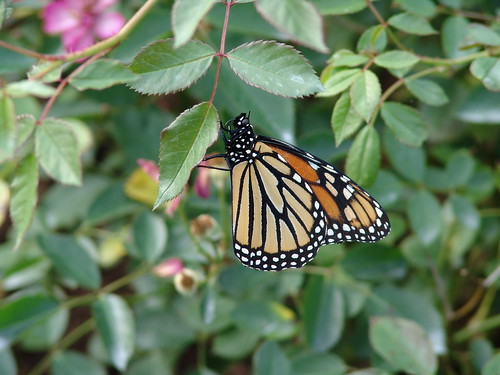 Last week I talked about the life cycle of butterflies and how you can create a garden with features important to caterpillars as well as adult butterflies. Today we’ll look at some of the plants that both prefer.
Last week I talked about the life cycle of butterflies and how you can create a garden with features important to caterpillars as well as adult butterflies. Today we’ll look at some of the plants that both prefer.
When designing a butterfly garden, first find out the kinds of butterflies you can expect to see in your area so that you’ll know what you need to attract them into your garden. Shop in the Garden and the LuEsther T. Mertz Library have a wonderful collection of books on the subject.
Some of the common butterflies you will find in the New York area are the spicebush swallowtail, black swallowtail, eastern tiger swallowtail, monarch, viceroy, clouded sulphur, buckeye, spring azure, and pearl crescent.
Good nectar sources for regional butterflies are lilacs (Syringa), clover (Trifolium), chives (Allium), cosmos (Cosmos), zinnias (Zinnia), lavender (Lavandula), catmint (Nepeta), milkweed (Asclepias), mint (Mentha), bee balm (Monarda), blazing star (Liatris), phlox (Phlox), anise hyssop (Agastache), bugbane (Cimicifuga), butterfly bush (Buddleja), summersweet (Clethra), blue mist shrub (Caryopteris), and glossy abelia (Abelia).
Posted in Exhibitions, The Edible Garden on July 23 2010, by Plant Talk
Demonstration Shows How to Put Up Your Own at Home
 |
Eugenia Bone is a veteran food writer and author of Well-Preserved. She will present canning demonstrations at The Edible Garden Conservatory Kitchen on July 25 at 1 and 3 p.m. |
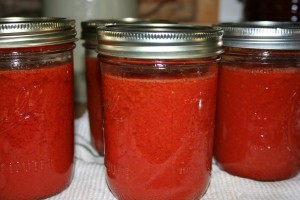 You may remember your grandmother putting up fruits in glass jars. Well, that practice is alive and well in New York City today, and it’s as safe and easy as it ever was.
You may remember your grandmother putting up fruits in glass jars. Well, that practice is alive and well in New York City today, and it’s as safe and easy as it ever was.
The motivation for urban and suburban canning is to have foods on hand to eat off-season (as well as for health, economic, and environmental reasons). All you have to do is decide what you’d really like to have stocked in the cupboard. People often ask me what is a good starter product for the beginner canner. I always say, whatever you like to eat! For me, that’s tomatoes. But to make it manageable, I put up a couple of pints at a time, when I am cooking dinner and hanging around the kitchen anyway.
Though tomatoes are a fruit, they have a pH usually of 4.5 or 4.6, which is just on the borderline of foods you can safely process in a water bath. For this reason, the Feds recommend you acidify all tomato products. You can use 2 tablespoons of lemon juice per pint, but I prefer a 1/4 teaspoon of citric acid. I buy 4-ounce jars of NOW citric acid online (www.nowfoods.com, keyword “citric acid”), and that does the trick of acidifying tomatoes beautifully.
I can tomatoes two ways, depending on how much time I have.
Posted in Shop/Book Reviews on July 21 2010, by Plant Talk
Authors of Books on Healthful, Sustainable Eating Come to the Garden
 John Suskewich is Book Manager for Shop in the Garden.
John Suskewich is Book Manager for Shop in the Garden.
No, “eating local” does not mean going to the Burger King that is down the block. It involves a set of conscious decisions about sourcing your chow in a way that emphasizes sustainability, nutrition, appearance, and taste, while leaving a smaller carbon trail.
Greenmarkets, community supported agriculture (CSA), produce exchanges, and farm stands are all manifestations of this concept. So, too, are celebrations like The Edible Garden, our summer into fall exhibition here at The New York Botanical Garden that is showcasing a number of chefs who create healthful recipes using harvest-based, seasonal, and organic ingredients.
Throughout The Edible Garden, Shop in the Garden is featuring a number of works by authors who believe that transforming our diet is critical not just to our own health but planet Earth’s health, too.
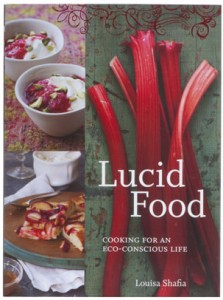 Louisa Shafia’s Lucid Food: Cooking for an Eco-Conscious Life is a cookbook with integrity. The first thing the author does is share all her “tried-and-true methods for putting a beautiful meal on the table while keeping a clear conscience.” Humane, seasonal, and sustainable are not bandied about like buzzwords but are used with passion and commitment. All this does not lead to cream of boiled water soup: the food is lovely, flavorful, and exotic, with concise recipes that don’t require specialized equipment or hard-to-find ingredients that need a flight to Damascus to get. The red-as-rhubarb jacket design is especially alluring. Louisa Shafia presented cooking demos at our Conservatory Kitchen and signed copies of Lucid Food this past Sunday (July 18).
Louisa Shafia’s Lucid Food: Cooking for an Eco-Conscious Life is a cookbook with integrity. The first thing the author does is share all her “tried-and-true methods for putting a beautiful meal on the table while keeping a clear conscience.” Humane, seasonal, and sustainable are not bandied about like buzzwords but are used with passion and commitment. All this does not lead to cream of boiled water soup: the food is lovely, flavorful, and exotic, with concise recipes that don’t require specialized equipment or hard-to-find ingredients that need a flight to Damascus to get. The red-as-rhubarb jacket design is especially alluring. Louisa Shafia presented cooking demos at our Conservatory Kitchen and signed copies of Lucid Food this past Sunday (July 18).
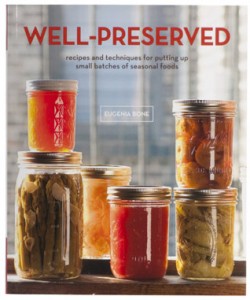 Our grandparent’s secrets of putting food by (yes, we ate their homemade pickles that came out of a dubious-looking, scum-covered barrel set like a secret in a curtain-covered pantry—and lived to tell about it) are revealed by Eugenia Bone in Well-Preserved: Recipes and Techniques for Putting Up Small Batches of Seasonal Foods. Sure I can freeze my own blueberries, but after that I’m all thumbs and a bit of a nervous Nellie, as I’m a little afraid of sending a houseful of dinner guests to the emergency room even if they have health insurance. Eugenia Bone describes even difficult techniques like water bath canning, curing, and smoking in a reassuring way so that even a novice will be turning out house-made gravlax in no time. Eugenia Bone will show how to do it and sign copies of her book this Sunday, July 25.
Our grandparent’s secrets of putting food by (yes, we ate their homemade pickles that came out of a dubious-looking, scum-covered barrel set like a secret in a curtain-covered pantry—and lived to tell about it) are revealed by Eugenia Bone in Well-Preserved: Recipes and Techniques for Putting Up Small Batches of Seasonal Foods. Sure I can freeze my own blueberries, but after that I’m all thumbs and a bit of a nervous Nellie, as I’m a little afraid of sending a houseful of dinner guests to the emergency room even if they have health insurance. Eugenia Bone describes even difficult techniques like water bath canning, curing, and smoking in a reassuring way so that even a novice will be turning out house-made gravlax in no time. Eugenia Bone will show how to do it and sign copies of her book this Sunday, July 25.
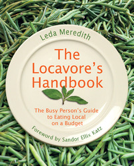 The Locavore’s Handbook: The Busy Person’s Guide to Eating Local on a Budget, by Leda Meredith, is an introduction and guide to eating locally for everyone, but seems especially geared for budget-minded city folk. The virtue of this book is that it actually is practical, showing you how to consume sustainably without breaking your (grass-fed, humanely raised) piggy bank. It has very useful money-saving tips on menu planning, growing and harvesting (even when your back 40 is that many inches of balcony), bartering, even packaging. Leda Meredith, an instructor here at NYBG, will be talking about her life as a locavore and signing copies of her book on Sunday, August 15.
The Locavore’s Handbook: The Busy Person’s Guide to Eating Local on a Budget, by Leda Meredith, is an introduction and guide to eating locally for everyone, but seems especially geared for budget-minded city folk. The virtue of this book is that it actually is practical, showing you how to consume sustainably without breaking your (grass-fed, humanely raised) piggy bank. It has very useful money-saving tips on menu planning, growing and harvesting (even when your back 40 is that many inches of balcony), bartering, even packaging. Leda Meredith, an instructor here at NYBG, will be talking about her life as a locavore and signing copies of her book on Sunday, August 15.
Posted in Exhibitions, The Edible Garden on July 20 2010, by Plant Talk
Soil and Seasons Are Key, Says Stone Barns Farm Manager
 |
Jack Algiere is the Four-Season Farm Manager at Stone Barns Center for Food and Agriculture in Pocantico Hills, New York. He co-curated one of The Edible Garden’s Celebrity Chef Kitchen Gardens with Dan Barber, Executive Chef and Co-Owner of Blue Hill. |
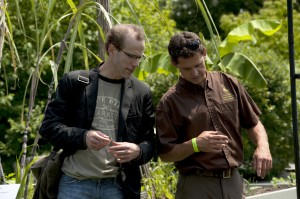 As we dance our way through the seasons, Dan Barber (pictured left with me) reminds me often that I (the farmer) lead the way. If this is so, I have learned all my moves from watching and imitating the nimble flow of nature. Whether the tarantella or a tomato salad, the principles remain the same: communication and respect.
As we dance our way through the seasons, Dan Barber (pictured left with me) reminds me often that I (the farmer) lead the way. If this is so, I have learned all my moves from watching and imitating the nimble flow of nature. Whether the tarantella or a tomato salad, the principles remain the same: communication and respect.
Understanding the fundamentals of the soil and the seasons is key to growing delicious food for nourishing and inspiring meals. At Stone Barns, we rely on several principles to maintain balance in our ecosystem, and these principles can guide the home gardener as well.
First, recognize that the whole of nature exhibits diversity and change. In the garden we replicate this through a balanced rotation of diversified crops. My preference is to diversify by plant families such as the nightshade, legume, mustard, or chicory.
Posted in Gardening Tips on July 19 2010, by Sonia Uyterhoeven
 |
Sonia Uyterhoeven is Gardener for Public Education. Join her each weekend for home gardening demonstrations on a variety of topics in the Home Gardening Center. July 31 and August 1 she will present Butterfly Bonanza. |
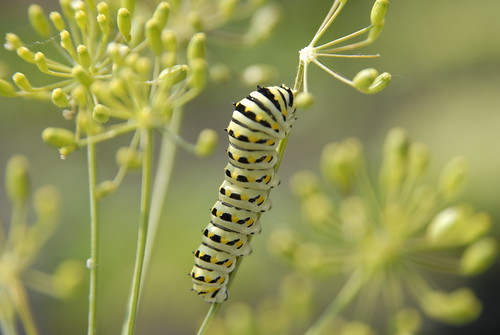 When we think of wildlife and gardening, sometimes the initial perception is that the two should remain separate, when the reality is that they are entirely interdependent. If you tell people to encourage insects into their garden, their nose often curls. Rephrase it and say “invite butterflies into your garden” and frowns turn into smiles.
When we think of wildlife and gardening, sometimes the initial perception is that the two should remain separate, when the reality is that they are entirely interdependent. If you tell people to encourage insects into their garden, their nose often curls. Rephrase it and say “invite butterflies into your garden” and frowns turn into smiles.
Aside from an appreciation of their beauty, why would it serve us to attract butterflies into the garden? Butterflies are second to bees as our most important plant pollinator. They are also sensitive to the environment and act as a good indictor of how healthy the environment is. From an educational standpoint, they provide a wonderful connection to the natural world and a way of teaching children the importance of the food web.
When you see a tiny winged creature flutter by, how can you tell if it’s a butterfly or a moth? Butterflies are active during the day, while moths are usually nocturnal. Butterflies have slim bodies, while moths are fat and hairy. When a butterfly lands, it rests with wings closed; moths rest with their wings open. Butterflies have antennae that are shaped like mini golf clubs; the antennae of moths are either feathery or straight.
Posted in Exhibitions, Learning Experiences, The Edible Garden on July 16 2010, by Plant Talk
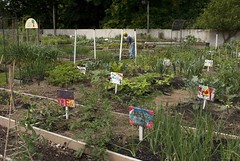 From digging in the Children’s Vegetable Garden to pretending to harvest fruits and vegetables at the Farm-to-Table play station, it’s easy for families to make a connection with food while having fun during The Edible Garden, which runs through October 17. From digging in the Children’s Vegetable Garden to pretending to harvest fruits and vegetables at the Farm-to-Table play station, it’s easy for families to make a connection with food while having fun during The Edible Garden, which runs through October 17.
Explore nature in the Everett Children’s Adventure Garden
Gardening fun in the Ruth Rea Howell Family Garden
All proceeds of The Edible Garden benefit the Children’s Gardening program. |
Posted in Exhibitions, The Edible Garden on July 15 2010, by Plant Talk
Chef Inspired by Greenmarket; Gives More Cooking Demos this Weekend
 |
Trish Sebben-Krupka is Corporate Chef for the Viking Culinary Center and Carl Schaedel and Co., and owner of Local Girl Makes Food, a culinary education and personal chef business. Her recipes appear in The Best of Vegan Cooking. She will present cooking demonstrations at The Edible Garden’s Conservatory Kitchen July 17 and August 14 at 1 and 3 p.m. Viking is a Supporting Sponsor of The Edible Garden. |
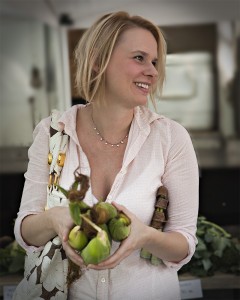
I pulled into the Garden’s Mosholu gate last Wednesday, excited to return to the Greenmarket. With five basic pantry ingredients and $25, I planned to see how far we could stretch this budget into delicious, family-friendly meals. My pantry included salt, pepper, olive oil, red wine vinegar, and hot sauce, things that are ordinarily found in just about any home kitchen.
I wandered through the Greenmarket, accompanied by Adriana Pecunia, my friend and fellow chef. Our $25 was spent quickly, and we walked away with a bag brimming with fresh corn, tiny new potatoes, red onions, flat romano green beans, tomatoes, parsley, cilantro, purslane, gold ball squash, zucchini, basil, carrots, and a petite baguette. I also managed to talk one of the farmers into making a deal on two quarts of tart red cherries.
We then made our way to the Conservatory Kitchen, where people were seated awaiting our Cooking for Your Health demonstration despite the incredible midday heat. I was excited to see that the high school-aged participants in the Botanical Garden’s GardenWorks program had joined us, as I love to show young people new foods and cooking techniques. This program, in partnership with the Bronx Institute’s Gear Up program, introduces students to new experiences and career choices in botanical science, horticulture, and education.
Adriana and I got cooking right away, making a light and healthful vegetable soup with onions, carrots, potatoes, green beans, zucchini, and corn, along with some fresh herbs and my favorite ingredient of the day: tart, lemony, purslane.